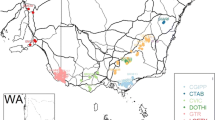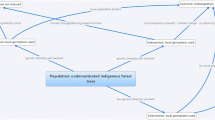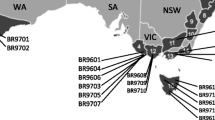Abstract
Radiata pine plantation resources in Australia and New Zealand are a highly productive source of solid-wood and pulp products for domestic consumption and export. This has largely been achieved through long-term investments in tree breeding programs that select the best-performing genotypes for varied regional environments. However, climate change could threaten the realisation of genetic improvement in plantations due to suboptimal matching of improved planting stock to new climate conditions. Here, we investigate how information from genetic field tests could be utilised under anticipated climate change. We use principal component analysis and Mahalanobis distance measures to find the closest match between climate of plantation regions in the future and current climate of field test sites. By 2050, future climates of some important plantation regions are expected to match climates currently present in different regions. For example, future climates of Green Triangle, a key plantation region in Australia, will better match current climate of Western Australia. The Central North Island of New Zealand will shift to warmer and wetter climate with no current analogue, and Western Australia, to warmer and drier no-analogue climate. The latter is also likely to fall outside the climate niche where radiata pine can be grown in the future. Nevertheless, for the majority of radiata pine plantation regions in Australia and New Zealand our analysis provides a framework of how anticipated climate change can be addressed in tree improvement programs using existing field tests.





Similar content being viewed by others
References
ABARES (2014) Australian forest and wood products statistics: March and June quarters 2014. Australian Bureau of Agricultural and Resource Economics and Sciences, Department of Agriculture, Canberra, November CC BY 3.0
Battaglia M, Bruce J, Brack C, Baker T (2009) Climate change and Australia’s plantation estate: analysis of vulnerability and preliminary investigation of adaptation options. For Wood Prod Aust. http://www.fwpa.com.au/rd-and-e/resources/81-climate-change-and-australia-s-plantation-estate-analysis-of-vulnerability-and-preliminary-investigation-of-adaptation-options.html. Accessed 15 Dec 2014
Bureau of Meteorology, CSIRO (2014) State-of-the-climate report. http://www.csiro.au/Outcomes/Climate/Understanding/State-of-the-Climate-2014.aspx. Accessed 15 Dec 2014
Department of Agriculture (2010) Land use of Australia 2005–2006—National Map—ESRI GRID. http://data.daff.gov.au/anrdl/metadata_files/pa_luav4g9abl07811a00.xml. Accessed 15 Dec 2014
Espinoza SE, Martínez VA, Magni CR, Ivković M, Santelices RE, Guerra FP, Cabrera AM (2014) Genetic control of growth, biomass allocation, and survival under drought stress in Pinus radiata D. Don seedlings. Tree Genet Genomes 10:1045–1054
Gapare WJ, Ivković M, Dutkowski GW, Spencer DJ, Buxton P, Wu HX (2012) Genetic parameters and provenance variation of Pinus radiata D. Don. ‘Eldridge collection’ in Australia 1: growth and form traits. Tree Genet Genomes 8:391–407
Gapare WJ, Ivković M, Liepe KJ, Hamann A, Low CB (2015) Drivers of genotype by environment interaction in radiata pine as indicated by multivariate regression trees. For Ecol Manag 353:21–29
Gavran M (2014) Australian plantation statistics 2014 update. Bureau of Agricultural and Resources Economics and Sciences, Technical report 14.2
Gray LK, Gylander T, Mbogga MS, Chen PY, Hamann A (2011) Assisted migration to address climate change: recommendations for aspen reforestation in western Canada. Ecol Appl 21(5):1591–1603
Hamann A, Wang T, Spittlehouse DL, Murdock TQ (2013) A comprehensive, high-resolution database of historical and projected climate surfaces for western North America. B Am Meteorol Soc 94:1307–1309
Hijmans RJ, Cameron SE, Parra JL, Jones PG, Jarvis A (2005) Very high resolution interpolated climate surfaces for global land areas. Int J Clim 25:1965–1978
IPCC (2013) Summary for Policymakers. In: Stocker TF, Qin D, Plattner G-K, Tignor M, Allen SK, Boschung J, Nauels A, Xia Y, Bex V, Midgley PM (eds) Climate change 2013: the physical science basis. Contribution of working group I to the Fifth Assessment Report of the intergovernmental panel on climate change. Cambridge University Press, Cambridge
Ivković M, Gapare W, Yang H, Dutkowski G, Buxton P, Wu H (2015) Pattern of genotype by environment interaction for radiata pine in southern Australia. Ann For Sci 72(3):391–401
Kirschbaum MUF, Watt MS (2011) Use of a process-based model to describe spatial variation in Pinus radiata productivity in New Zealand. For Ecol Manag 262:1008–1019
Kirschbaum MUF, Watt MS, Tait A, Ausseil GE (2012) Future wood productivity of Pinus radiata in New Zealand under expected climatic changes. Glob Change Biol 18:1342–1356
LRIS NZ (2014) LCDB v4.0—Land Cover Database version 4.0. Land Resource Informtion System, New Zealand. https://lris.scinfo.org.nz/layer/412-lcdb-v40-land-cover-database-version-40/. Accessed 29 June 2015
MAF (2014) National exotic forest description as at 1 April 2014. Wellington, Ministry of Agriculture and Forestry. http://www.mpi.govt.nz/document-vault/4948. Accessed 15 Dec 2014
Mead DJ (2013) Sustainable management of Pinus radiata plantations. FAO forestry paper no. 170. FAO, Rome
Meinshausen M, Smith SJ, Calvin K, Daniel JS, Kainuma MLT, Lamarque J-F, Matsumoto K, Montzka SA, Raper SC, Riahi K, Thomson A, Velders GJM, van Vuuren DPP (2011) The RCP greenhouse gas concentrations and their extensions from 1765 to 2300. Clim Change 109:213–241
Mitchell TD, Jones PD (2005) An improved method of constructing a database of monthly climate observations and associated high-resolution grids. Int J Climatol 25(6):693–712
O’Neill GA, Ukrainetz NK, Carlson MR, Cartwright CV, Jaquish BC, King JN, Krakowski J, Russell JH, Stoehr MU, Xie C, Yanchuk AD (2008) Assisted migration to address climate change in British Columbia: recommendations for interim seed transfer standards. Technical Report 048. Research Branch, British Columbia Ministry of Forest and Range, Victoria, p 38
Palmer DJ, Höck BK, Kimberley MO, Watt MS, Lowe DJ, Payn TW (2009) A comparison of spatial prediction techniques for developing Pinus radiata productivity surfaces across New Zealand. For Ecol Manag 258:2046–2055
Pedlar JH, McKenney DW, Aubin I, Beardmore T, Beaulieu J, Iverson L, O’neill GA, Winder RS, Ste-Marie C (2012) Placing forestry in the assisted migration debate. Bioscience 62(9):835–842
Pinkard L, Bruce J (2011) Climate change and South Australia’s plantations: impacts, risks and options for adaptation. CSIRO Technical Report to PIRSA
Pinkard L, Bruce J, Battaglia M, Matthews S, Drew D, Downes G, Crawford D, Ottenschlaeger M 2014 Adaptation strategies to manage risk in Australia’s plantations. Forest and wood products Australia Limited. http://www.fwpa.com.au/rd-and-e/resources.html. Accessed 15 June 2015
R Development Core Team (2014) R: a language and environment for statistical computing. R Foundation for Statistical Computing, Vienna
Raymond CA (2011) Genotype by environment interactions for Pinus radiata in New South Wales, Australia. Tree Genet Genomes 7:819–833
Venables WN, Ripley BD (2002) Modern applied statistics with S, 4th edn. Springer Verlag, New York
Walter H, Lieth H (1967) Klimadiagram-Weltatlas. VEB Gustav Fischer Verlag, Jena
Wang T, Hamann A, Spittlehouse DL, Murdock T (2012) ClimateWNA—high-resolution spatial climate data for Western North America. J Appl Meteorol Clim 51:16–29
Wu HX, Matheson AC (2005) Genotype by environment interaction in an Australia-wide radiata pine diallel mating experiment: implications for regionalised breeding. For Sci 51:29–40
Acknowledgments
We gratefully acknowledge funding from the Forest and Wood Products Australia (FWPA PNC246-1112), Radiata Pine Breeding Company (RPBC) and Southern Tree Breeding Association (STBA) to CSIRO. Natural Sciences and Engineering Research Council of Canada, Grant #RGPIN 330527 enabled Andreas Hamann to participate in this research. The collaboration was carried out under the auspices of a Sir Frederick McMasters Fellowship to Andreas Haman and CSIRO. We also thank Peter Buxton of STBA and Paul Jefferson of RPBC for field test data, and Andrew Dunningham of SCION for lending us his GIS expertise.
Author information
Authors and Affiliations
Corresponding author
Electronic supplementary material
Below is the link to the electronic supplementary material.
11056_2015_9510_MOESM1_ESM.pdf
Description of regional climates in Australia and New Zealand. Walter and Lieth (1967) climate diagrams of radiata pine plantations in Australia and New zealand. The plots report region and the 10th to 90th percentile of the elevation range of plantations in the title. Below the title, mean annual temperature (MAT) and mean annual precipitation (MAP) are reported. Mean maximum temperature of the warmest month (MaxTWM) and mean minimum temperature of the coldest month (MinTCM) are shown next to the y-axis. (PDF 974 kb)
Rights and permissions
About this article
Cite this article
Ivković, M., Hamann, A., Gapare, W.J. et al. A framework for testing radiata pine under projected climate change in Australia and New Zealand. New Forests 47, 209–222 (2016). https://doi.org/10.1007/s11056-015-9510-8
Received:
Accepted:
Published:
Issue Date:
DOI: https://doi.org/10.1007/s11056-015-9510-8




